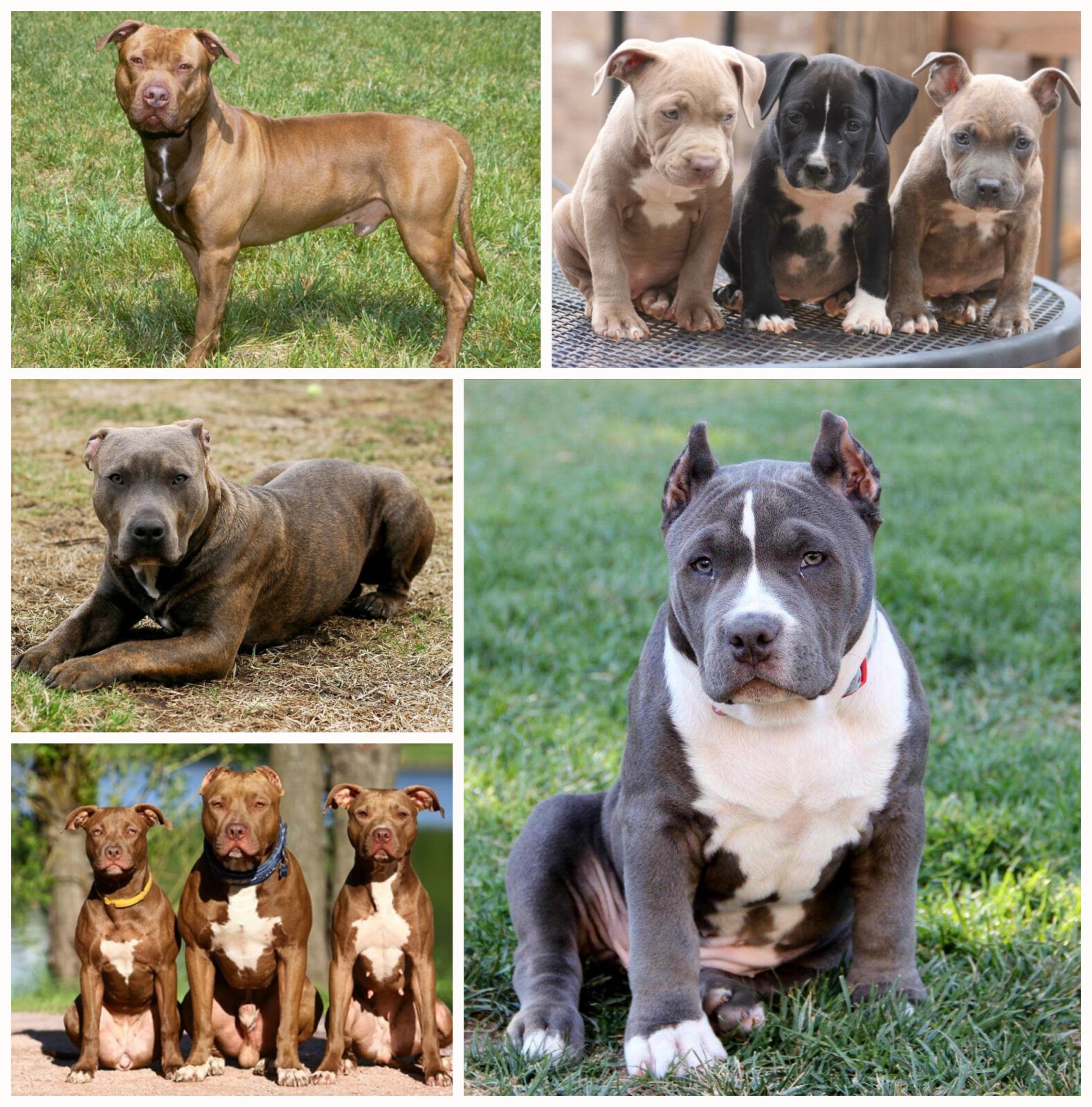Американский питбультерьер, сокращенно питбуль (Pitbull) — американская собака средних размеров, которая относится к одной из разновидностей питбулей. Эту породу часто сравнивают с американским стаффордширским терьером и стаффордширским бультерьером.
Краткое описание породы
Рост питбуля составляет от 45 до 60 сантиметров, а вес может варьироваться от 15 до 30 килограммов. Собаки этой породы мускулисты и имеют сбитое телосложение. Для своих размеров питбуль очень силен. Клиновидная голова достаточно большая, но не массивная и вполне симметрична остальным частям тела. На лбу собаки присутствуют небольшие складки. Шерсть этих собак короткая. Что касается окраса, то он может быть любым. Питбули бывают однотонными и нескольких цветов. Так же как и окрас, различным может быть и цвет глаз, но вот только не бывает синеглазых питбулей. Короткий хвост собаки имеет коническую форму.
Американский питбультерьер относится к собакам-компаньонам и семейным собакам. Изначально эта породы выводилась в качестве некой «приманки» для быков. Позже этих собак начали выводить для участия в боях, ну а еще позже питбультерьеры стали семейными собаками. Кстати, эти собаки, несмотря на свой характер, хорошо ладят с детьми.
Упорство питбулей, их мужество и активность, делают их отличными спортсменами, а также непревзойденными питомцами, которые с успехом справляются с заданиями на ловкость и послушание.
Американского питбультерьера относят к так называемым «собакам-хулиганам». Стоит отметить, что «питбуль» — это не порода, а просто обозначение для описания американского питбультерьера, бультерьера, американского стаффордширского терьера и стаффордширского бультерьера. При этом некоторые люди склонны думать, что все эти разновидности – абсолютно одинаковые собаки. На самом деле это не совсем так. Сама путаница началась в 1930 году, когда Американский клуб собаководства признал американского стаффордширского терьера отдельной породой, а американского питбультерьера – нет.
Сегодня сложился стереотип о том, что питбультерьер — это опасная собака. Всему виной послужило то, что животных выводили специально для участия в собачьих боях, поэтому у них выработался соответствующий характер. Не будем, конечно же, скрывать, что в последние годы было немало случаев проявления агрессии со стороны питбулей.
На самом же деле, обстоятельства складываются так, что большинство случаев агрессии собак этой породы единичны. Подобные ситуации широко освещаются в СМИ, но эти случаи, как уже было отмечено, единичны. Таким образом, стереотип опасной собаки сложился из-за халатного отношения людей к информации относительно случаев агрессии.
Каждый владелец питбуля должен знать, что он может столкнуться с недоверием и даже гневом людей в отношении вас, как владельца «опасной» собаки. Всему виной – дезинформация. Эта порода не для каждого, особенно не для тех, кто не готов тратить свое время на достойное воспитание или же не может обеспечить последовательное, четкое обучение.
При достаточной социализации и квалифицированном обучении из питбультерьеров выходят отличные собаки-компаньоны, которые хорошо ладят с детьми. Они любят находиться с людьми и нежны с ними. Зачастую собаки этой породы обожают встречать и ждать своего хозяина у двери. Американские питбули преданные и верные своей семьей. При необходимости они всегда придут на помощь своему хозяину и членам семьи.
Щенки питбуля очень умны. Они легко поддаются дрессировке и с удовольствием выполняют различные команды. Питбули обожают участвовать во всех семейных мероприятиях. Даже в зрелом возрасте питбули могут вести себя как щенки, но это поведение проявляется только в родной обстановке. Купив щенка этой породы, вы будете удивляться, как раньше вы могли жить без питбуля.
Основная информация
| Название породы: | Американский питбультерьер |
| Страна происхождения: | США |
| Время зарождения породы: | XIX век |
| Тип: | терьеры |
| Вес: | 15 – 30 кг |
| Рост (высота в холке): | 45 – 60 см |
| Продолжительность жизни: | 10 – 15 лет |
|
Классификация МКФ:
|
не признана |
| Цена щенков: | 110 – 450 $ |
| Самые популярные клички: | список кличек для питбуля |
Оценка характеристик породы
| Адаптивность
(определение, означающее, насколько легко собака может приспосабливаться к изменениям в жизни) |
🐶🐶🐶 |
| Уровень линьки
(Уровень и частота выпадения волос у животного) |
🐶🐶 |
| Уровень нежности
(Уровень и количество нежности и ласки, которую собака отдает взамен на внимание к себе) |
🐶🐶🐶🐶🐶 |
| Потребности в упражнениях
(Уровень дневной активности собаки) |
🐶🐶🐶 |
| Социальная потребность
(Необходимое количество контактов собаки с другими животными, а также людьми) |
🐶🐶🐶🐶 |
| Квартирное содержание
(Фактор, определяющий уровень шума и иных неудобств, которые собака может доставлять хозяевам в соотношении размера квартиры к размеру собаки) |
🐶🐶 |
| Груминг
(Количество купаний, расчесываний, а также необходимое количество сеансов профессионального груминга, необходимого собаке) |
🐶 |
| Дружелюбность в незнакомой среде
(Особенности поведения собаки в обществе с незнакомыми людьми или в незнакомой обстановке) |
🐶🐶🐶🐶 |
| Тенденция к лаю
(Склонность к лаю и его частоте и громкости) |
🐶🐶🐶 |
| Вопросы здоровья
(Потенциальный уровень состояния здоровья собаки) |
🐶🐶🐶 |
| Территориальность
(Склонность собаки к защите своего дома, двора или даже автомобиля хозяина) |
🐶🐶🐶 |
| Дружелюбность к котам
(Тенденция к терпимости к кошкам и пониженное проявление охотничьих инстинктов) |
🐶 |
| Интеллект
(Способность собаки к мышлению и решению возникающих трудностей (не стоит путать с обучаемостью!) |
🐶🐶🐶🐶 |
| Воспитание и дрессировка
(Уровень сложности в обучении собаки выполнять определенные действия) |
🐶🐶🐶🐶 |
| Дружелюбность к детям
(Фактор, определяющий насколько собака дружелюбна к детям, любит ли она с ними играть и терпеть некоторые детские шалости) |
🐶🐶🐶🐶 |
| Игровая активность
(Понятие определяется самим его названием, и, как правило, встречается почти у всех собак) |
🐶🐶🐶🐶 |
| Наблюдательность
(Способность собаки определить присутствие чужого на своей территории) |
🐶🐶🐶 |
| Дружелюбность к другим собакам
(Склонность собаки находить общий язык с другими своими сородичами) |
🐶 |
Американский питбультерьер фото:

История происхождения
Питбули были выведены в начале 19 века в Англии для участия в популярных тогда травлях быка и медведя. Но эти виды спорта в 1835 году были признаны негуманными и жестокими и были запрещены. На их место пришли собачьи бои. Следовательно, в собаках нарочно культивировалась агрессия, которая впоследствии сохранилась на генетическом уровне. Но у этих собак есть и другая генетическая особенность — нежелание кусать людей. Позже заводчики начали работать над тем, чтобы поведение собаки на ринге и в семье отличалось. Как результат, порода начала завоевывать популярность и стала вливаться в семьи, проявляя свои наилучшие качества.
Когда питбуль попал на американский континент, особо востребован он стал на фермах. Животные отлично справлялись с заданиями по охоте на дичь, они охраняли имущество и были просто непревзойденными компаньонами. В Америке заводчики начали работать над увеличением размера собак этой породы. В результате питбуль в США стал намного крупнее, чем его собратья в Англии.
В 1898 году Британский клуб собаководов (аналог Американского клуба) назвал эту породу американским питбультерьером. А вот Американский клуб собаководов признал породу в начале 1930-х годов, но уже под новым названием. Намереваясь отделить породу от ее предков — боевых собак, клуб решил назвать породу американским стаффордширским терьером.
С тех пор американский стаффордширский терьер стал официально появляться на различных выставках, в то время как собак породы американский питбультерьер встретить на официальных мероприятиях было невозможно.
Характер американского питбультерьера
У питбулей очень распространена агрессия. Боевой характер все еще присутствует у многих представителей этой породы. Агрессия может проявляться даже тогда, когда собака воспитывается с самого детства с кошками или другими собаками. Такой скверный характер говорит о том, что во время прогулок с питомцем нужно проявлять максимум внимания и не оставлять животное без присмотра. Если вы заметили, что другие собаки обращают на вашего питомца внимание или же наоборот, то его нужно сразу увести с площадки. Конечно же, питбуль всегда должен находиться на надежном поводке, а двор, в котором будет проживать питомец, и проводить там время, необходимо надежно огородить.
На питбультерьерах с самого рождения лежит клеймо бойцовской собаки. Всему виной новости и сообщения в газетах об агрессии некоторых представителей этой породы. Во многих западных странах переполнены приюты с питбулями, а в некоторых даже запретили их выведение. Само название породы вселяет в некоторых людей страх. Такие опасения в большинстве случаев необоснованны. Питбули очень воспитаны, если они живут в любящей семье. Они верны и надежны, это отличные собаки-компаньоны. Они обожают находиться рядом с людьми и желают быть среди своей семьи, принимать участие в ее жизни. Любые мероприятия, будь-то прогулка по лесу, выезд на пикник или просто посиделки во дворе, необходимо проводить вместе с питомцем. Если питбуль будет чувствовать, что его любят и заботятся о нем, он ответит тем же.
Содержание и уход
Ухаживать за питбулем совсем несложно. Их всего лишь нужно купать по мере необходимости, еженедельно расчесывать, а также время от времени протирать влажной тканевой салфеткой. Этого будет вполне достаточно, чтобы поддерживать шерсть в здоровом и красивом состоянии.
Уши американского питбультерьера требуют регулярного контроля на наличие признаков загрязнений, раздражений и инфекций. Очищают ушные раковины специальным тампоном и средством, назначенным ветеринаром. При этом никогда нельзя использовать ватный тампон для чистки ушного канала.
Также еженедельно необходимо чистить зубы питбулю. Это предотвратит возникновение зубного камня, укрепит десна и предупредит возникновение неприятного запаха из ротовой полости. Когти обрезают раз в месяц, если, конечно, собака сама их не стачивает.
Дрессировка и обучение
Процесс обучения американского питбультерьера нужно начинать в раннем возрасте. Дрессировка питбуля должна проходить в спокойной, ненапористой манере. Обучение должно предполагать не очень длинные занятия, но промежутки между ними также должны быть короткими. В противном случае питомцу все быстро надоест даже в том случае, если вы будете предлагать лакомства.
Во время дрессировки собак этой породы необходимо запастись терпением, так как процесс может затянуться. Даже хорошо обученные питбультерьеры могут со временем вести себя избалованно, проверяя таким образом, что им можно, а что — нет. В таких ситуациях необходимо вести себя спокойно, но дать собаке понять, что этого делать нельзя.
Если в семье есть дети, то щенок должен начать с ними общение с первого дня появления в доме. Примечательно, что, несмотря на то, что питбули, как правило, отлично ладят с детьми в семье, могут проявлять недоверие и даже агрессию к чужим детям. Вот почему в период социализации американского питбультерьера необходимо научить собаку понимать, что ко всем детям необходимо хорошо относиться.
Здоровье и болезни американского питбультерьера
Несколько интересных фактов
- Американский питбультерьер — не самый лучший выбор для людей, у которых нет много свободного времени.
- Собаки этой породы должны быть обучены и социализированы в раннем возрасте. Это необходимо, чтобы предотвратить проявление в характере упрямства и агрессии, с которыми в виду силы этой собаки, бороться нелегко.
- Во время прогулок питбуль должен быть на поводке. Ни в коем случае нельзя выходить в общественные места без поводка, иначе вы рискуете тем, что собака затеет настоящий бой со своими сородичами.
- Если американский питбультерьер не социализирован должным образом в щенячьем возрасте, то его владелец рискует получить не собаку-компаньона, а агрессивного питомца.
- Если вы решите путешествовать с питбулем, удостоверьтесь в том, что ввоз в страну собак этой породы не запрещен.
- Американские питбультерьеры склонны к жеванию. Прикупите достаточное количество различных жевательных игрушек, чтобы предостеречь повреждение мебели или декора, которые собака может начать жевать.
- Питбули лучше всего подходят тем, у кого много свободного времени и масса желания и терпения воспитывать питомца.
Питомники и заводчики
Материал мы заимствовали с замечательного сайта наших партнеров DOGCATFAN.COM о кошках и собаках, автор dogcatfan

